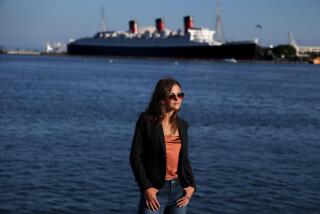A Solar-Powered Surprise
Employing a dogged pace and an experimental vehicle that ran amazingly free of breakdowns, Cal State L.A. on Saturday won a nine-day, 1,250-mile race of solar-powered cars, finishing fewer than 20 minutes ahead of second-place Massachusetts Institute of Technology.
Driven by Roman Vasquez of Montebello, the low-slung, flame-yellow Solar Eagle III crossed the finish line in Colorado Springs, Colo., with a cumulative time of 28 hours, 41 minutes and 34 seconds to edge the MIT vehicle.
Vasquez, lead driver for the Los Angeles team, said reliability proved to be the difference in Sunrayce 1997. The race began June 19 with 36 teams at the Indianapolis Motor Speedway and traveled over highways and back roads across five states.
“We never had a problem at all,” he said. “In the nine days of the race, they awarded a winner every day, and we never had a first-place finish through out the whole race. We finished second once. It was the fact we never broke down.”
This was the third time Vasquez and co-driver Dylan Wakasa, both civil engineering majors, had entered the race. The pair finished fourth in 1990, and in 1993 they posted a “very disappointing” third because of an electrical failure, Vasquez said.
“The third time is the charm,” said Cal State L.A. spokeswoman Carol Selkin.
“We probably were not the most efficient car here, and we weren’t the lightest or most aerodynamic, but we certainly were the most reliable,” Vasquez said.
School President James M. Rosser flew to Colorado to meet the Solar Eagle III as it crossed the finish line before noon. For students and race enthusiasts, updates were available over the nine days via the Internet and a special Solar Eagle hotline.
The victory for a design team of a dozen students and a faculty advisor, mechanical engineering professor Dick Roberto, was a surprising win over nationally known schools with much better funding.
“In the past, the winners were big-name schools with four-year research institutions and big money,” Selkin said. “We’re a state university with no research arm. These other schools had people clamoring to support their team, doctors and lawyers. We just didn’t have that.”
Selkin said the school had no experience in designing or building a solar vehicle before 1988, when it was first invited to take part in the competition.
The race features student teams driving cars of their own design and construction that run by converting solar energy to electricity.
“We entered our first race not knowing what we were getting into,” Selkin said.
In 1990, the school finished fourth after building its first solar-powered car using monetary donations and materials from local sponsors. That experience led several students to pursue careers in alternative energy, Selkin said.
This year, the team felt it could win.
Traveling an average of 140 miles a day at speeds ranging between 40 and 50 mph, the Solar Eagle III is a testimony to simplicity, a solar panel with wheels and just enough room for its student driver.
“It looks like a spaceship out there on the road,” Selkin said. “It’s long and sleek and low to the ground. It fits one person tightly, and that has to be a smallish person.”
The cars were accompanied by support vehicles, whose drivers discouraged looky-loos along rural roads who would pull up behind or in front of the solar-powered cars, causing distractions and one accident.
The 36 solar-powered cars rolled into Limon in eastern Colorado on Friday, the last stop before they crossed the finish line. The racers left Limon at intervals beginning at 10 a.m. Saturday to race the final 76 miles under cloudy skies, not the best conditions for cars that run on the sun’s rays.
The cars passed through Indiana, Illinois, Missouri and Kansas on the way to Colorado. Teams were clocked during each leg of the race, with the win going to the car with the lowest cumulative elapsed time.
The 27-year-old Vasquez said the team ran the 427-pound car on a test track near Mojave. But that was nothing like the real race, in which the driver sat cramped for hours at a time, in constant radio contact with the support cars to avoid getting lost on the rural roads.
“You could zone out after awhile in that car; it’s not like you could turn on radio,” he said. “The race wasn’t a ride in the park. You were always listening for information on the road. It was easy to get lost.
“These weren’t the smoothest roads. They were mainly secondary highways. And you were in a vehicle designed right on the edge of reliability.”
For Vasquez, the best part was crossing the finish line in front of a cheering crowd, a full 20 minutes ahead of his closest competitor.
“I felt like I was coming home,” he said. “I mean, it wasn’t Los Angeles, but it was the next best thing.”
Times wire services contributed to this story.







